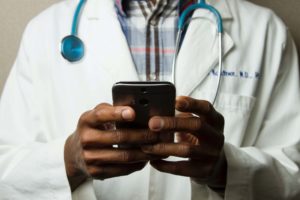It’s looking like 2020 will be a deeply challenging year for global health. As the COVID-19 virus (Coronavirus) crisis unfolds, an enormous strain is being placed on the healthcare system – confirmed cases of the virus across America are steeply rising, quarantine measures are complicating the ability of patients to access medical care, and the financial fallout of the crisis has presented never-before-seen supply chain and healthcare delivery challenges.
On top of the more front-and-center challenge of providing immediate medical care, the crisis is putting unprecedented strain on healthcare information and technological infrastructure. It’s unclear whether the U.S. healthcare system is prepared to carry the weight, but it’s already apparent that significant changes in the ways things like patient data, patient and provider communication, and supply chain processes are managed will be required.
Faced with a truly global pandemic, the role of healthcare IT and innovation has never been more critical. Here are a few ways that the healthcare IT world is – or could soon be – responding to the COVID-19 crisis.
Building a digital product?
Patient-centered experiences could ease the healthcare burden of COVID-19
Many patients have reported less than optimal experiences trying to get tested for the Coronavirus. Without focusing on the patient perspective, developers could miss opportunities to diminish the effects of the virus. The information patients need may go unseen and the data hospital networks are looking for may go unreported.
For example, one Chicago man reported that when he showed up to the clinic with Coronavirus-like symptoms, he didn’t meet the criteria for the test. The hospital deemed self-quarantine unnecessary – only to call him back three days later to get tested for the virus. Not only did that patient lose three days of possible diagnosis, but he could have exposed others to the virus during that time. In this case, sacrificing the patient-centered focus is a mistake that could have very real, and deeply damaging consequences.
Modern hospital networks typically try to cater to as many patients in need as possible, balance logistics and still focus on a patient-centric approach. Giving patients and end-users what they want is an essential step to creating a pleasant user experience in healthcare. Especially during high-stress times like these, healthcare software should cater to an authentic patient journey. That means potentially redesigning basic patient communication systems and experiences, or looking to expand the capabilities of existing digital tools to accommodate the radically different patient expectation during a global pandemic.
For companies creating tools specifically to combat the COVID-19 crisis, every detail of their software matters. The founders of Abi Global Health have responded to the virus by hyper-focusing on the UX effects of their platform. The AI-powered chatbot app helps patients during the “first-mile” of their healthcare journey. Abi effectively reduces physician time per case and in-person visitation; two critical advantages amid the pandemic. CEO and co-founder Kim-Fredrik Schneider explains the significance of UX optimization right now:
“Downloading an app, finding a private space with good lighting and a stable internet connection, getting dressed and ready for a video call when you are feeling unwell; these barriers can be a terrible user experience (UX) for people used to instant service via their mobile devices. A bad UX can lead to inefficient healthcare utilization, which takes a huge financial toll on society; the cost of people going to the doctor when they shouldn’t is $50bn, while people not going when they should costs at least $500bn.” (Forbes).
Most individuals (and most organizations) have not experienced a public health emergency like this one, so it’s difficult to predict how different Americans are reacting. Evidation Health, a healthcare technology company, is using a patient engagement app to survey over 100,000 U.S. citizens about their thoughts on the pandemic. They found that less than 23% of Americans believe the country was prepared for the virus. They also found that between those with health insurance and those without, “[t]he latter group more often said that they would not seek care if they developed coronavirus symptoms (8% versus 21%), and those who would more often said that they would most likely go to an emergency room (19% versus 26%)” (MobihealthNews). These analysis points can help providers track how behaviors may change over time and develop solutions beforehand.
Could supply chain analytics help U.S. healthcare networks be better equipped to handle COVID-19?
Hospital beds per 1,000 people, via the OECD:
- South Korea: 12.3
- Germany: 8.0
- France: 6.0
- China: 4.3
- Italy: 3.2
- United States: 2.8
https://t.co/yKavMnNMpm https://t.co/RkhwSTDhb0 pic.twitter.com/kJ57iavncJ
— Christopher Ingraham (@_cingraham) March 11, 2020
As the number of confirmed cases of COVID-19 grows, so does the concern for supplies – and the supply chain providing them. USA Today’s conservative guess is “there could be six seriously ill patients for every existing hospital bed” They suggest the gap exists partly because the outbreak hit during the peak of flu season. Hospital beds aren’t the only dilemma. Because the virus causes respiratory issues, masks and ventilators are also in high demand.
Some options other countries have turned to were rapidly building more hospitals or, more gravely, limiting care based on age range. One tool American healthcare professionals might want to turn to is data. Effective data analysis can help hospitals with inventory management and cutting costs in healthcare supply chains. one way to fight the pandemic might be to deploy predictive analytics and data-sourcing tools to try and find opportunities for cost-reduction and greater efficiency.
In other words, if we optimize our hospital supply chains now, we may be better equipped to handle large volumes of patients during the peak of COVID-19 diagnoses later.
Establishing supply chain transparency paves the way for responding to unplanned circumstances, and a better understanding of potential demand could allow for medical supplies to be on-site before the need hits. Achieving transparency may include creating a risk index for each supply type based on critical supplier information. Additionally, capacity and distribution optimization could ensure that critical tests aren’t needlessly delayed and furthering the effects of an already devastating virus like COVID-19.
In Philadelphia, Penn Medicine’s predictive healthcare team has pioneered a tool that helps hospitals prepare for the incoming influx of Coronavirus cases. COVID-19 Hospital Impact Model for Epidemics (CHIME) utilizes SIR modeling, an epidemiological model, to predict the expected count of the COVID-19 diagnoses in a closed population. The software will help hospitals project the number of hospital admissions they might obtain each day and, therefore, prepare their supply chains accordingly. The open-source app was created so that other hospitals can also make use of it by adjusting the perimeters to their specific populations. Penn Medicine hopes CHIME will reduce some of the uncertainty that comes with the Coronavirus, and get hospitals on track to manage the inevitable surge of patients.
Patient data sharing and portability is critical for tracking the spread and impact of COVID-19
The number of confirmed coronavirus cases in the U.S. went from 15 cases on February 15th, to more than 46,000 reported cases across the states as of March 24. But even that number isn’t entirely accurate – keeping track of confirmed coronavirus cases in real-time has been a struggle. Infectious disease expert Jeffery Shaman told Buzzfeed News that he wouldn’t be surprised if over 50,000 Americans have been infected with the disease at this point. That leaves thousands of Americans being left unrecognized by the U.S. healthcare system. The lack of testing is a huge contributor to that data gap. Is it possible that software could help solve the issue?
Lab researchers of Augusta University in Georgia seem to think so. Dr. Arni S.R. Srinivasa Rao, Director of the Laboratory for Theory and Mathematical Monitoring at Augusta is working with a team of developers to create a free app that helps identify those who are at high risk for contracting COVID-19.

Using a list of symptoms, data about cases in that geographical region, and data from other respondents of the survey, the AI-powered app will use an algorithm to send users a risk assessment. The app will then direct high-risk users to the nearest accredited testing facility. An app like this could help hospitals skip at least some of the screening processes they currently conduct on-site and get likely victims to the hospitals and away from the uninfected.
Healthcare professionals also believe data-mining could more effectively identify hospital outbreaks. According to Lee H. Harrison MD of the University of Pittsburgh, “[r]eal-time data mining could have averted 66% of possible preventable infections if an intervention was implemented within 14 days of identifying the transmission route” (Helio, Feb 20).
Telehealth will be critical for delivering healthcare during the COVID-19 pandemic
During a pandemic, visiting the hospital can carry its own risks. Americans will benefit from sending as few people with unrelated issues to the hospitals as possible. As telemedicine gains popularity in the healthcare industry, it’s getting a special amount of attention at the moment.
Doctors are suggesting that telemedicine is critical to flattening the curve. The movement is even getting support from the government. On Tuesday, the Trump administration announced that telemedicine services will be temporarily waived by Medicare, making it easier for healthcare providers to host Medicare-reimbursable office visits through telehealth services. The HHS Office of Inspector General (OIG) is also allowing healthcare providers to “reduce or waive cost-sharing for telehealth visits paid by federal healthcare programs”. Private insurers are also looking to cover telehealth practices by waiving costs for virtual visits.
Telemedicine has quickly transitioned from a healthcare “nice-to-have” to a need. G. Cameron Deemer, president of DrFirst, highlights three main roles for telehealth amid the pandemic:
- Keeping more hospital beds available by providing in-home care
- Protect those with previously existing conditions from a potentially fatal coronavirus diagnosis
- Allowing quarantined healthcare providers to see patients through remote channels as they are highly exposed and in limited supply
Telemedicine does not come without its complications, however. While telehealth practices are being gradually adopted nation-wide, most hospitals are not yet equipped to operate virtually. With insurance complications, a lack of hardware, and gaps in knowledge on both the provider and patient-front, telehealth won’t always be a simple system to establish.
Nevertheless, organizations are paving the way for virtual visits in their hospitals. Seat Pleasant, a small “smart city” community in Maryland, is responding to the virus by partnering with companies to embark on a $200 million telehealth project. Telemedicine giant Amwell has also reported a 158% increase in app usage nationwide. Telehealth may have a chance to shine amidst an otherwise gloomy time for healthcare.
Deploying emerging technologies in the face of a global pandemic
The immediate and almost unprecedented challenge of the COVID-19 pandemic is also bringing some still-emerging technologies to bear, as organizations seek new and better tools to manage the increased resource demands.
The US Department of Energy is putting its Summit computer, the fastest computer on Earth, up to the task of finding a cure for the virus. Summit computer operators are hopeful that the computer will run simulation results to learn more about which compounds may produce a useful vaccine.
Silicon Valley companies are also looking to employ artificial intelligence to curtail the damage of the virus. Tech giants like Facebook, Google, LinkedIn, Microsoft, Reddit, Twitter, and YouTube have all agreed to help stop the spread of misinformation about the COVID-19 online. Although the technology isn’t error-proof yet, the organizations are relying heavily on AI to identify offensive or incorrect information being posted on their platforms. YouTube, for example, is using an automated moderator system to find content that violates their policies, but admits the system still needs work.
Sign up for HealthWire to get the latest health tech headlines delivered to your inbox
It’s still too early to understand what the full extent and impact of the COVID-19 pandemic will be, but it’s already abundantly clear that U.S. healthcare systems are facing an almost unprecedented challenge. That means that healthcare software developers, healthcare professionals, and the government all face a responsibility to rise to the occasion. By pulling together, leveraging new and emerging technologies, and tackling this unprecedented challenge, the healthcare industry will hopefully find ways to learn from this crisis and ultimately be better prepared for future public health emergencies.



